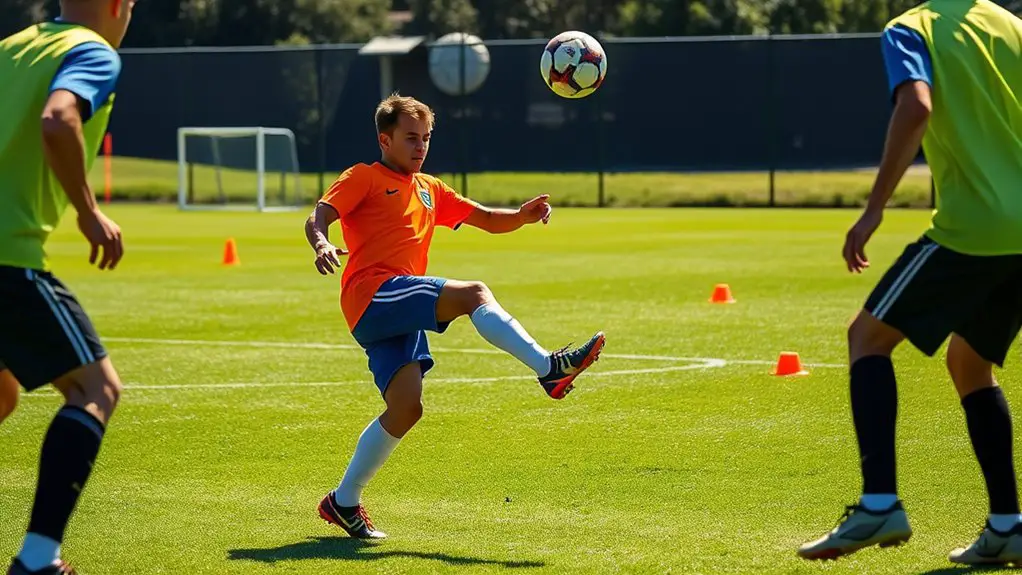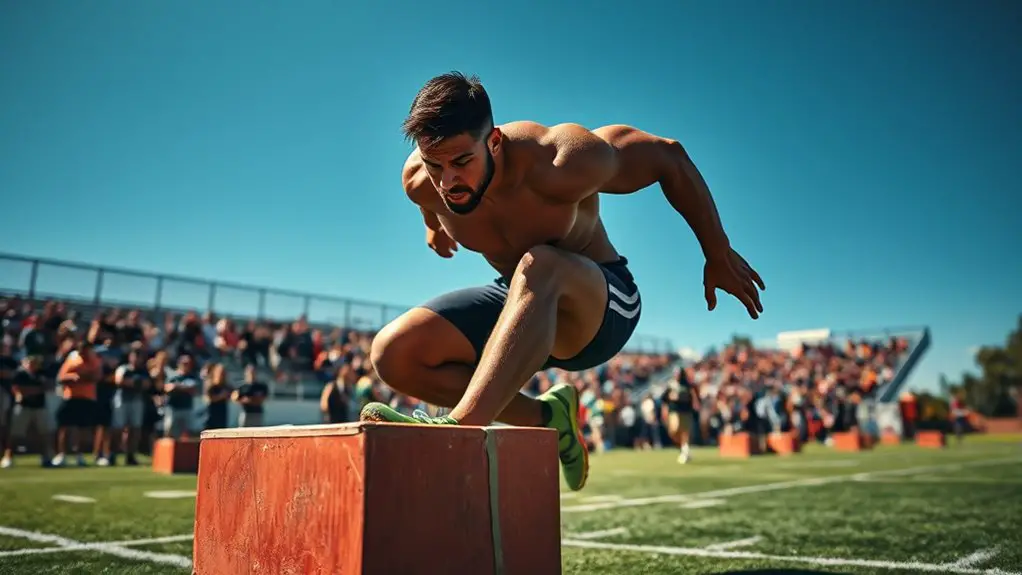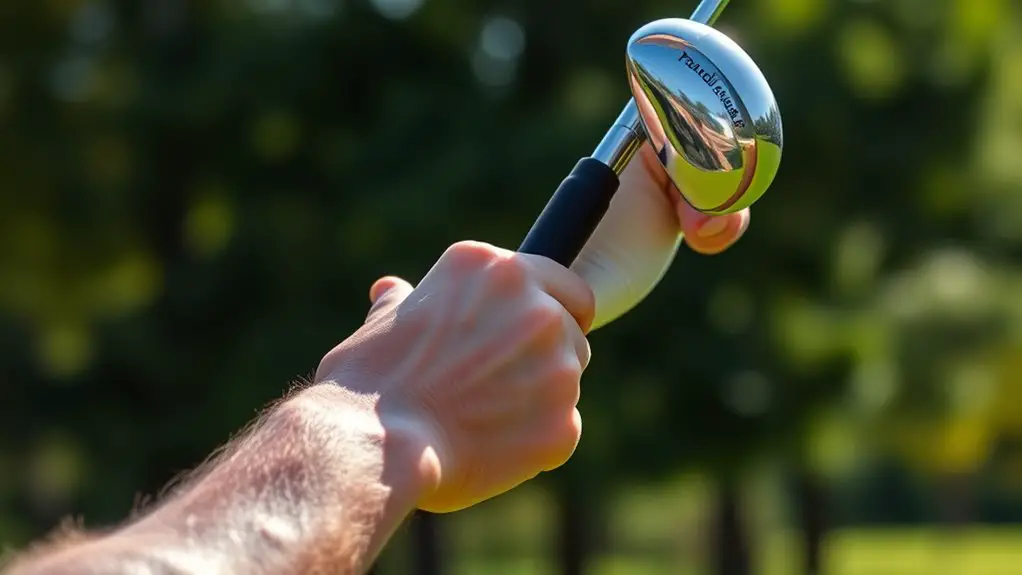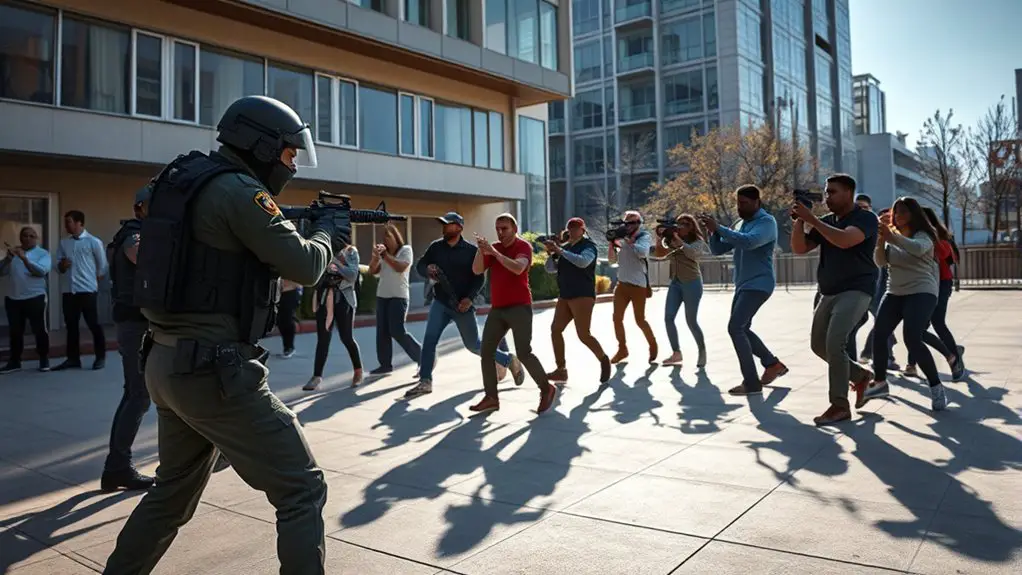To improve your first touch and ball control under pressure, practice using various parts of your body for better reception. Engage in drills like wall passes and juggling to enhance control. Simulate high-pressure situations during practice to develop resilience. Incorporate small-sided games to refine your skills in a competitive setting. Finally, use mental strategies like visualization and deep breathing to stay composed when it counts. Discover more techniques to elevate your game further.
Understanding the Importance of First Touch
Mastering the first touch is essential for any aspiring soccer player, as it sets the tone for every subsequent action on the field. The importance of first touch can't be overstated; it determines how effectively you control the ball and how quickly you can shift into your next move. A clean first touch allows you to maintain possession, evade defenders, and create scoring opportunities, thereby greatly impacting gameplay.
Imagine receiving a pass with ease, giving you the freedom to make decisions without panic. Each successful first touch builds your confidence, enabling you to express your skills and creativity on the pitch. When you prioritize developing this fundamental skill, you empower yourself to influence the game and take control of your destiny. So, invest time in honing your first touch, and watch how it transforms your performance, allowing you to play the beautiful game with flair and freedom. Additionally, improving footwork drills can further enhance your first touch by promoting better positioning and control.
Key Techniques for Improving Ball Control
Once you've grasped the importance of first touch, the next step is to focus on key techniques that will enhance your ball control. Start by practicing various touch techniques, like using different parts of your foot, thighs, and chest to receive the ball. This diversity helps you adapt to any situation on the field. Additionally, work on control exercises that challenge your ability to maintain possession under pressure. For instance, try juggling or dribbling through cones, allowing you to become comfortable with the ball at your feet. Incorporating agility drills into your training routine can significantly improve your footwork and overall control.
Drills to Enhance Your First Touch
To truly elevate your first touch, incorporating specific drills into your training routine can make a significant difference. Start with the wall pass drill; kick the ball against a wall and focus on controlling it with your first touch as it rebounds. This helps develop precision and timing.
Next, try the juggling drill. Juggling the ball with your feet, thighs, and head enhances your ball control while improving your feel for the ball.
Finally, set up cones or markers and practice receiving passes from a partner or a coach. As the ball approaches, concentrate on using different parts of your foot to guarantee a smooth first touch.
These drills not only sharpen your first touch but also build confidence in your ability to control the ball, allowing you to express your skills freely on the field. Get creative and enjoy the process!
Practicing Under Pressure
Although practicing under pressure can be intimidating, it's essential for developing your ability to handle the ball in game situations. Embracing pressure situations helps you adapt, making you more resilient and confident on the field. High intensity training is key; it forces you to make quick decisions while maintaining control.
Start by incorporating drills that simulate game-like pressure. For instance, have a teammate apply pressure as you receive and control the ball. The more you expose yourself to these scenarios, the better you'll become at managing stress during an actual match.
You can also practice in small-sided games, where space is limited and opponents are relentless. This environment encourages you to refine your first touch and ball control while under duress. Additionally, integrating agility training techniques can help you improve your overall performance as you learn to navigate tight spaces effectively. Remember, the goal is to stay relaxed and focused. Over time, you'll find that you thrive in pressure situations rather than shy away from them.
Incorporating Game Scenarios in Training
When you incorporate game scenarios into your training, you create a realistic environment that mirrors the challenges you'll face during actual matches. This approach not only sharpens your first touch but also enhances your ball control under pressure. By using game-based exercises, you can simulate various situations that demand quick decision-making and situational awareness.
For instance, set up drills that mimic defensive pressure or create small-sided games where you're forced to make rapid decisions. This not only improves your technical skills but also helps you recognize patterns in play, allowing you to anticipate moves from opponents. Moreover, practicing in dynamic settings fosters adaptability, ensuring you're ready for any game situation. Remember, the more you engage in these realistic scenarios, the more instinctive your reactions will become on the field. Incorporating mental alertness and awareness into your training methods will further enhance your ability to respond quickly under pressure. So, embrace these training methods and watch your confidence and performance soar!
Mental Strategies for Composure on the Field
While the physical aspects of the game are essential, mental strength is equally important for maintaining composure on the field. To enhance your ability to stay calm under pressure, consider incorporating visualization techniques into your routine. Picture yourself in high-pressure situations, calmly receiving the ball and executing your next move flawlessly. This mental rehearsal can boost your confidence and prepare you for real-game scenarios.
Additionally, mindfulness practices can help ground you in the moment. Take a few deep breaths before a match or during intense moments to center yourself. Focus on the sensations of your body and the rhythm of your breath, allowing distractions to fade away. By cultivating deeper awareness through mindfulness, you can break free from distractions that hinder your performance.
Frequently Asked Questions
How Can I Assess My Current First Touch Skills Effectively?
To assess your current first touch skills effectively, consider using self-assessment techniques like video analysis. Record yourself during practice and review the footage to evaluate your control and reaction under pressure. You can also implement skill evaluation methods, such as setting up drills that challenge your touch in various situations. By doing this, you'll gain a clearer understanding of your strengths and areas needing improvement, allowing you to play with more freedom and confidence.
What Common Mistakes Should I Avoid During Practice?
Imagine you're a bird soaring through the sky, free from burdens. During practice, avoid common mistakes that can clip your wings. Don't let poor practice habits sneak in; they'll weigh you down. Focus on your mental game—stay present and engaged. Also, resist the urge to rush; it can lead to sloppy touches. Remember, every practice should feel like a step toward liberation, not a chore. Embrace the freedom that comes with mastering your skills!
How Often Should I Practice Ball Control Drills?
You should aim to practice ball control drills at least three times a week. This frequency helps reinforce skills without overwhelming yourself. Mix in a variety of drills to keep things interesting and challenge different aspects of your control. Whether it's juggling, dribbling, or passing against a wall, variety's key to improvement. Ultimately, find a balance that fits your schedule and keeps you motivated, so you enjoy the freedom of playing your best.
Can Specific Footwear Impact My First Touch?
Can the shoes you wear really make a difference in your game? Absolutely! The right footwear technology can enhance your first touch by providing better ball feel and control. With improved traction benefits, you'll find it easier to pivot and change direction, allowing for more fluid movement under pressure. So, if you want that freedom to express yourself on the pitch, investing in quality footwear might just be your game-changing decision!
What Role Does Physical Fitness Play in Ball Control?
Physical fitness plays a critical role in ball control. When you engage in endurance training, you build stamina, allowing you to maintain focus and composure during intense moments. Strength conditioning enhances your core stability and leg power, giving you the ability to control the ball with precision. Feeling fit means you're more relaxed and confident on the field, ultimately freeing you to express your skills without hesitation, leading to better overall performance.




